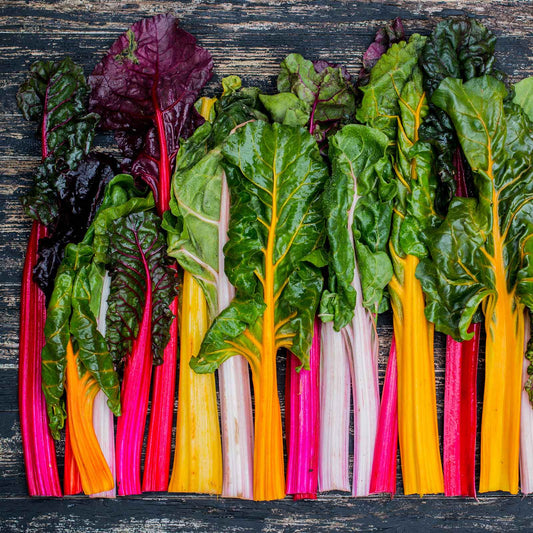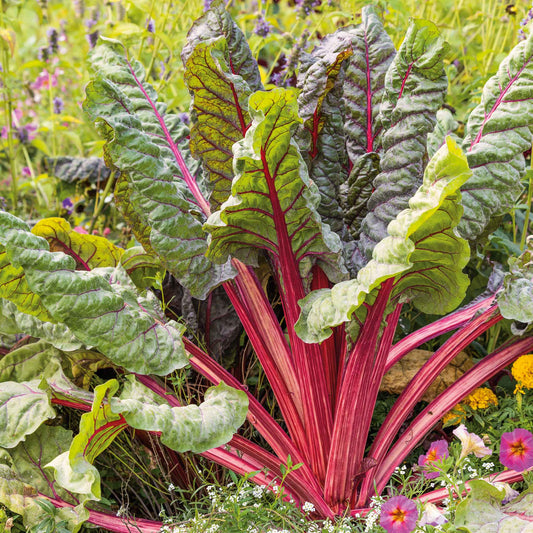-
main-collection-product-grid

Swiss Chard Seeds (Organic) - Rainbow of Lights
Ornamental variety that's tender to eatSwiss Chard Seeds (Organic) - Rainbow of Lights
Ornamental variety that's tender to eatRegular price As Low As $6.99Regular priceUnit price per -
main-collection-product-grid

Swiss Chard Seeds (Organic) - Ruby Red
Nutritious, delicious and attractiveSwiss Chard Seeds (Organic) - Ruby Red
Nutritious, delicious and attractiveRegular price As Low As $6.99Regular priceUnit price per
Why organic Swiss chard is the perfect leafy green
- Organic, cool-season leafy vegetables
- Drought-tolerant greens are less likely to bolt than spinach or lettuce
- Can be eaten raw or cooked
- Approximately 20 days until maturity once planted
The best organic swiss chard for your home garden
Fun fact: Swiss chard isn’t actually native to Switzerland but to the Mediterranean. This leafy vegetable is a relative of beets and spinach, and you can tell—chard has the bold colors of beetroot but the sweet taste of spinach. Swiss chard is more heat and drought-tolerant than its cousins, though, so you can enjoy fresh chard in the hottest part of the summer, when your spinach is probably already bolting.
Organic Swiss chard can tolerate light frosts and should be direct-seeded two or three weeks before the last spring frost. To give your plants a jump start on the season, chard seeds may be started indoors four to six weeks before the last heavy frost. For an autumn harvest, plant Swiss chard 40 days from the first fall frost. Young chard leaves are delicious and can be harvested when the leaves get about four inches tall. Baby chard has a milder taste than older chard, and the young leaves are perfect for salads! Mature chard leaves are harvestable at around eight inches. Organic Swiss chard is an easy-to-grow vegetable that thrives in poor soils.
Culinary ideas for organic swiss chard
Hot, dry weather may cause Swiss chard does taste somewhat bitter, but there are a few culinary techniques to mask the taste. Blanching or braising, pickling, and cooking with fat, salt, and acid are simple and inexpensive methods to enhance the earthy taste of this superfood. Enjoy organic Swiss chard midribs like celery, and separate the greens for wraps and sandwiches. Saute the whole leaf in oil or chop it up into a stew for a tasty, nutritional tonic. Know anyone with diabetes? Swiss chard contains nutrients that help regulate blood sugar, and protect your heart by lowering high cholesterol and high blood pressure. Swiss chard is also rich in antioxidants that fight cancer-causing free radicals. So forget apples. It's a chard leaf a day keeps the doctor away, now.
Using organic swiss chard for microgreens
Microgreens are becoming popular as a fun and easy way to consume more vegetables, and Swiss chard is a favorite for producing tasty seedlings. To grow organic Swiss chard as a microgreen, fill a seed tray with soil and multi-sow a pinch of Swiss chard seeds in every cell. Water as needed until the seedlings are two inches tall, or have their first set of true leaves. Use a pair of scissors to cut sections of seedlings at the base. Enjoy these microgreens within the first few days of harvesting, and schedule weekly succession plantings for a continuous harvest.
Whether you are already a fan of organic Swiss chard or you’ve yet to try it, this is the season to grow this beautiful superfood in your garden!
For more information about planting, growing, and harvesting organic Swiss chard seeds, see the Swiss Chard Seeds Planting Guide.

